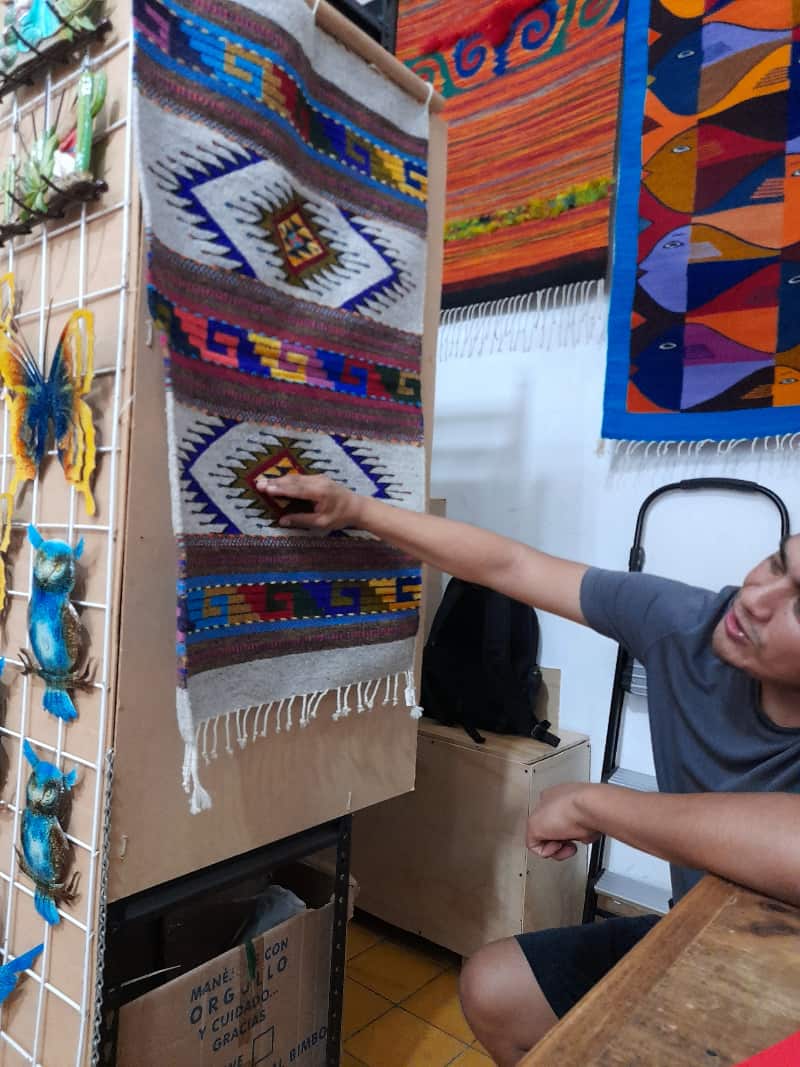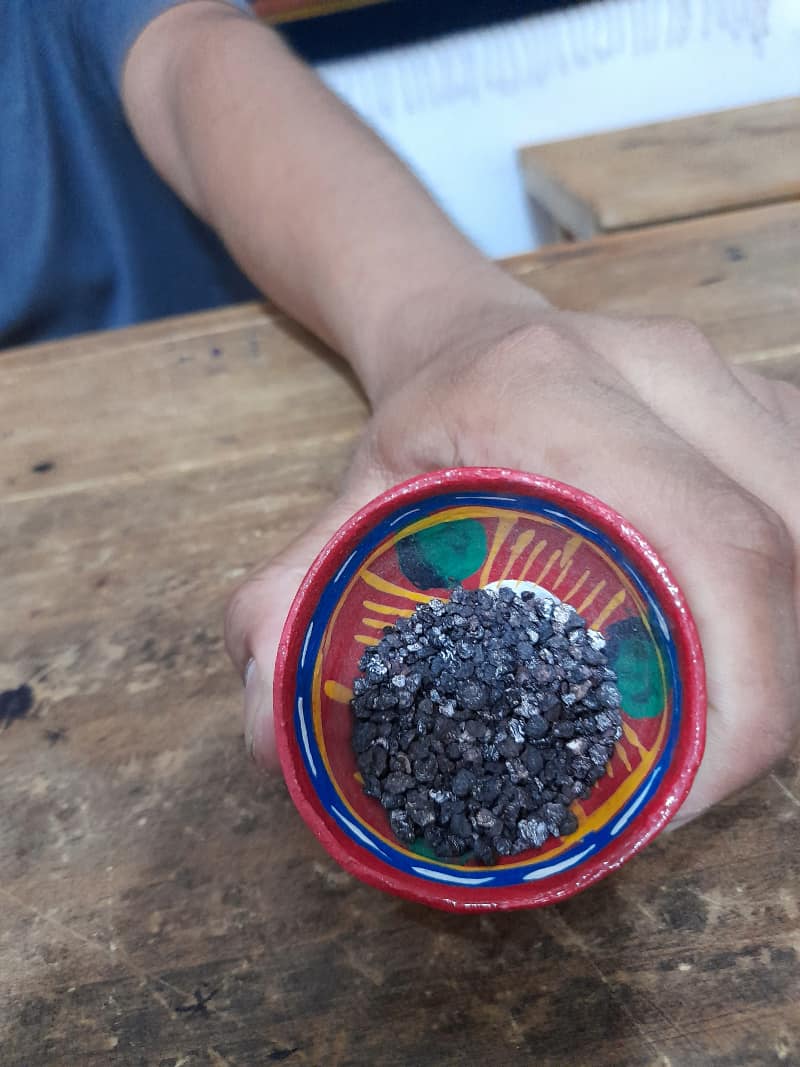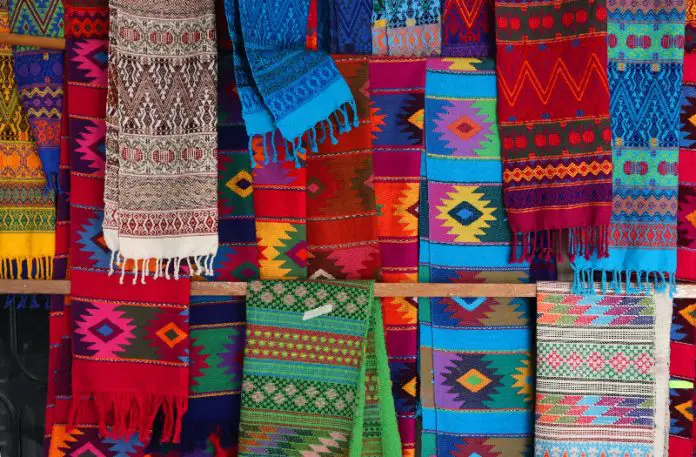A long history of Zapotec weaving
Zapotec weaving is an ancient art form that has been passed down from generation to generation for more than 2,000 years. The Zapotec civilization arose in the Central Valleys of Oaxaca in the 6th century BCE, building great cities like Monte Albán and Mitla. Roughly 400,000 Zapotecs — who call themselves Ben’Zaa, the Cloud People — live in Mexico today. As their ancestors did, modern Zapotecs use weaving as a way to preserve their traditions, history, stories and spiritual beliefs.

One of the oldest weaving tools used by Indigenous people is the backstrap loom, which is used by attaching one end to a tree or post and wrapping the other end around the waist. The weaver sways their body back and forth to change the tension in the threads. Without wool-yielding domestic animals, Mesoamerican weavers made textiles with plant fibers and cotton and traditionally only men were allowed to weave in the Zapotec culture.
During the height of the Zapotec civilization, the people of Teotitlán del Valle in Oaxaca were already known for their weaving. Their woven items were considered so valuable that it is said the Mexica Emperor Moctezuma II extracted an annual tribute of 2,000 blankets and 40 pounds of dried cochineal insects— used to make carmine dye —annually from each of the seven cities he ruled.
In the 16th century, the Spanish conquistadores brought sheep and the pedal loom to Mexico and Zapotecs began using sheep’s wool in their rugs. Male weavers transitioned to the pedal loom, which requires more strength, while women filled other roles in the process: preparing wool, spinning wool into yarn, and dyeing yarn. Eventually, Zapotec women began using the backstrap loom for weaving while men wove more oversized rugs on pedal looms. In the last 60 years, women have become around 80% of backstrap weavers while roughly 75% of weavers using the pedal loom are men.
Today’s Zapotec weaving process and materials

To learn more about the process and symbolism of Zapotec weaving, I sat down with my friend Luis Ruiz, a fifth-generation Zapotec weaver from Teotitlán del Valle. All 16 members of his family are weavers and still live in Teotitlán, where 80% of residents make their living from weaving. Luis has been a weaver for more than 21 years; his grandfather taught him how to weave at the age of three or four.
Ruiz’s large loom sits prominently in Legado Zapoteco, the small Oaxacan shop in Mazatlán’s Historic Center where he sells his rugs (called tapetes) along with artisanal work produced by several other families. Each family specializes in certain handcrafts like tinwork, black pottery and blankets, and together they form their own co-op.
Ruiz shows me the spindles of different colored yarn he is using in the rug he is currently weaving and demonstrates how to pass them horizontally through the vertical yarn to create designs while using the two floor pedals to change the tension of the threads.
The process of weaving is time-consuming and labor-intensive, Ruiz tells me: “It takes me two weeks to make a simple traditional rug but it can take a month or two to make more complicated designs or custom orders.” There is also the work that takes place before the actual weaving process: sheep, yak and alpaca wool is brushed with paddles and prongs to eliminate any debris and make the fibers lie in the same direction. The wool is then spun into yarn using a spinning wheel. “Each step of the process is typically completed by a different family,” Ruiz says. “Some families clean the wool which another family will spin into yarn. Then it goes to a family that specializes in the dyeing process,” he adds.
The dyes are organic, made from materials including tree moss, pomegranate skins, marigold, madrone bark, West Indian indigo and cochineal, a tiny insect that looks like white fuzz when found on nopal cacti leaves. The female cochineal excretes an acid that produces a deep crimson color, which has made it a hot commodity for centuries as a dye. According to Ruiz, “Some weavers mix their own dye color combinations and have specific colors that identify their rugs. No one else can reproduce that color because weavers don’t share their techniques or their secret dye recipe for the colors they create.”
Symbolism and meaning of Zapotec rugs
Traditional Zapotec rugs share common themes and symbols. Geometric pyramids represent the ancient political and economic center of Monte Albán. The zig-zag pattern represents lightning, which is connected to Cocijo, the Zapotec god of lightning and rain.

Ruiz explains the design of a traditional Zapotec rug: “The Geometric spiral called Greca (Greek) reflects the cycle of life according to the Zapotec cosmic vision and can be found on Zapotec pyramids. This theme always has four lines or levels starting at the bottom they symbolize birth and childhood, teenage years, and adulthood, and the top line which is the longest is old age. That line is the longest because at that point you have attained wisdom and know how to appreciate the time you have left. Next is a hooked part of the spiral which is death.”
Arrows are part of some themes due to their importance for hunting and warfare. Stars are the eyes of the gods expressing love to those on Mother Earth. Fish represent abundance and are typically arranged in a vertical line. The bottom fish represents the past and has an eye. If the fish at the top, which represents the future, does not have an eye, that means the weaver is still living.
The Eye of God, very prevalent in many rugs, symbolizes the power of seeing and understanding the unseen. The Eye of God is placed inside a diamond. The top half represents the sky or heaven, the bottom half is hell. If you cover the bottom half of the diamond, you can see a pyramid and the bottom half is a horizontal reflection of the pyramid symbolizing a mirror that reflects our inner life. The Eye of God is sometimes placed inside a rectangle representing the entrance to the spirit world and a sacred place of spirituality.
Zapotec weaving is a very spiritual and personal journey for weavers connecting them to their ancestors, beliefs and inner self. Like many of his generation, Luis sees himself as an artist. The older generation of weavers describe themselves as artisans.
Luis explains his artwork, “Making a rug is very special for me, not only because it is exciting to see the combinations and designs that you can create and the satisfaction of seeing the finished piece, but it also takes a lot of patience and time. During the time weaving the rug we, as weavers, impregnate the rug with our feelings: happiness, sadness, frustration, anger. When we finish a rug, it fills us with joy and it excites us when someone buys it because they not only have a unique piece made by hand, but they also have a little piece of our feelings and time.”
Sheryl Losser is a former public relations executive and professional researcher. She spent 45 years in national politics in the United States. She moved to Mazatlán in 2021 and works part-time doing freelance research and writing.
